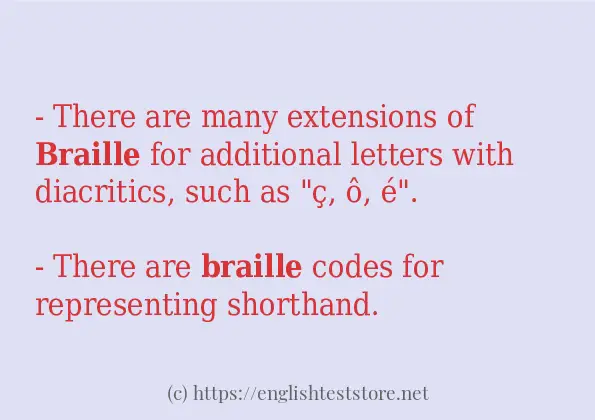How to use in-sentence of “braille”:
– There are many extensions of Braille for additional letters with diacritics, such as “ç, ô, é”.
– There are braille codes for representing shorthand.
– Cantonese Braille is also based on Latin braille for many of the initial consonants and simple vowels, but the blocks also have different values depending on whether they are in a leading syllable or following syllable position.
– Braille can be made using a “slate” and a “stylus” in which each dot is created from the back of the page, writing in mirror image, by hand, or it may be produced on a special braille typewriter or “Perkins Brailler”, or produced by a braille embosser attached to a computer.
– In Mandarin Mandarin Braille, which is based on Zhuyin rather than the Latin Pinyin alphabet, the Latin braille values are used for the first consonants and the simple vowels.
– This means that many things need more than one braille character to be coded.
– As first made by Louis Braille, the first group of characters, using just the top 4 dots of the braille cell, represents letters “a” through “j”.
– Braille‘s change was to use a 6 dot cell — the braille system — which completely changed how the blind would read and write.

Example sentences of “braille”:
– To make it possible to read faster, certain transcriptions of Braille use shortened words, or contractions.
– English braille has codes for the letters and some punctuation, and some double letter signs and word signs directly, but capitalization and numbers need a prefix symbol.
– Grade 1 braille is mostly used by beginners.
– Can Braille be revived? A possible impact of high-end braille and mainstream technology on the revival of tactile literacy medium.
– Aston was a blind writer and teacher who helped setup the Library of the Victorian Association of Braille Writers in 1894.
– At the beginning of a word, this same character stands for the word “to” although the character is written in braille with no space following it.
– The basic problem of Grade 1 braille is that braille “letters” are much larger than printed ones.
– This ‘tactile feature’ does not use standard braille but, instead, a system developed by working with blind and visually impaired Canadians after they found that not all people who needed it could read braille.
– Grade 2 braille uses contractions, which allows to save space and increase reading speed.
– Famous blind people have included Louis Braille, the inventor of the braille alphabet, Stevie Wonder, Ray Charles and Helen Keller.
– The Library keeps the National Reserve Braille Collection.
– There are also different braille codes in use for special purposes, like writing shorthand, mathematics or music.
– The six bit braille code is very limited, it only allows 64 different possible combinations.
– When braille is adapted to languages which do not use the Latin alphabet, the blocks are generally assigned to the new alphabet according to how it is transliterated into the Latin alphabet, not the alphabetic order of the national script.
– However, at least two adaptations of Braille have completely reassigned the Latin sound values of the blocks.
- To make it possible to read faster, certain transcriptions of Braille use shortened words, or contractions.
- English braille has codes for the letters and some punctuation, and some double letter signs and word signs directly, but capitalization and numbers need a prefix symbol.
- Grade 1 braille is mostly used by beginners.
